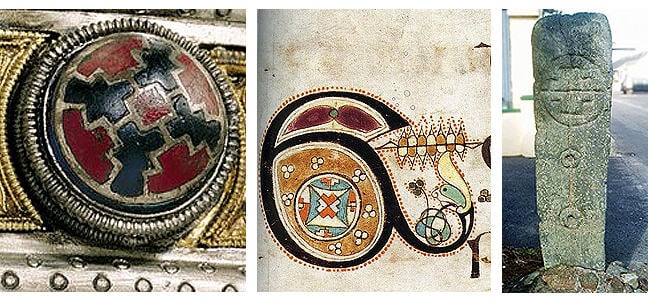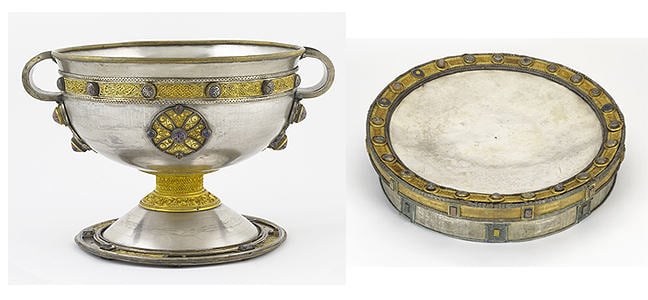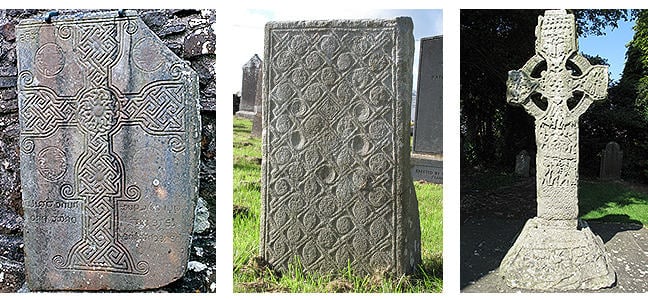The artistic background
The artistic background of the Book of Kells
124 comments
The Book of Kells is the best surviving example of a unique art style that flourished in Ireland between around 650 and 950AD.
Characterised by dense patterning overlying a tightly organized geometrical structure, individual design elements were drawn from a broad range of cultures, fused and developed with skill and imagination.
Key elements that characterise the style include:
- Spiral motifs, ultimately coming from the pre-Christian, Celtic world
- Abstracted, intertwined animals and birds common to early Germanic and Anglo-Saxon art
- Ribbons plated together into designs that had their origins in Mediterranean countries
Although commonly referred to as ‘Celtic’ art, this does not convey the full range of influences at play, so that more recently, this type of art has been called ‘Insular’ (from the Latin insulae, meaning islands), reflecting its origins on the islands of Ireland and Britain.
This minute, intricate art style was used to decorate manuscripts, fine metalwork and stone carvings. Indeed in some cases it is clear that the artists decorating books were taking inspiration from metal objects and vice versa.
 Fig 1. Glass ornamental stud on the Ardagh chalice c. 800 © National Museum of Ireland. Fig 2. Motif based on a glass stud on fol. 146r of the Book of Kells. © The Board of Trinity College, University of Dublin. Fig 3. Motif based on a glass stud on a pillar stone at Glencolumbcille, Co. Donegal Photo: Rachel Moss.
Fig 1. Glass ornamental stud on the Ardagh chalice c. 800 © National Museum of Ireland. Fig 2. Motif based on a glass stud on fol. 146r of the Book of Kells. © The Board of Trinity College, University of Dublin. Fig 3. Motif based on a glass stud on a pillar stone at Glencolumbcille, Co. Donegal Photo: Rachel Moss.
The majority of surviving Insular art was made for the Church. Important books, including gospel books and psalters (books of psalms or songs sung during worship) were typically decorated, emphasising the important role that they played in Christian worship. Vessels used in the celebration of the Mass, such as chalices (to hold the wine) and patens (to hold the bread) were decorated with a dense mesh of gold wires twisted into different shapes and coloured glass moulded and inset with silver, to emulate more valuable gem stones.
Good examples of these vessels include the famous Ardagh chalice and Derrynaflan paten dating to almost exactly the same time as the creation of the Book of Kells.
 Fig 4. The Ardagh chalice © National Museum of Ireland. Fig 5. The Derrynaflan paten © National Museum of Ireland
Fig 4. The Ardagh chalice © National Museum of Ireland. Fig 5. The Derrynaflan paten © National Museum of Ireland
Although not as minute in scale, stone carvers also produced some exquisite work during the period. These carvings were created as grave markers, parts of furnishings such as altars and shrines and as boundary markers. Most famous of all are the high crosses – tall, free standing stone crosses decorated with a mixture of abstract ornament and figurative scenes, the origins of which, like the Book of Kells, have been particularly linked to the churches associated with St Colum Cille.
 Fig 6. Grave slab at Tullylease, Co. Cork. Photo: Rachel Moss. Fig 7. Decorated structural stone, possibly part of an altar or shrine, from Lemonaghan, Co. Offaly. Photo: Rachel Moss. Fig 8. The ‘Tower cross’, Kells, Co. Meath. Photo: Rachel Moss.
Fig 6. Grave slab at Tullylease, Co. Cork. Photo: Rachel Moss. Fig 7. Decorated structural stone, possibly part of an altar or shrine, from Lemonaghan, Co. Offaly. Photo: Rachel Moss. Fig 8. The ‘Tower cross’, Kells, Co. Meath. Photo: Rachel Moss.
© Trinity College Dublin

Postar um comentário